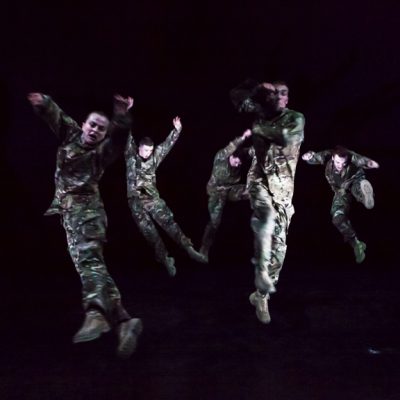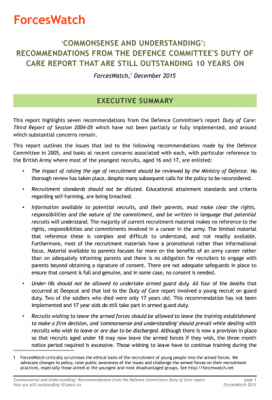risks
The militarisation of schools
23/01/2017The Independent
The Independent
The UK is one of few countries that allow minors to enlist. Despite calls to cease the recruitment of under-18s the Army is digging in to hold its ground.
Army life: the other side of the story

Telling adolescents that they can resolve their need to belong by joining the Army is simplistic and one-sided. The reality is many aspects of army life are potentially harmful, especially to vulnerable individuals. The other side of the story needs to be told. This is a longer version of an article first published by The Huffington Post
Enlisting at 16: the other side of the story
09/01/2017Child Soldiers International
Child Soldiers International
This series of 2-minute films by Child Soldiers International give a powerful insight into the reality of signing up as a young recruit, how training brutalises young soldiers and the long-term harmful effects of training and combat.
Army defies child rights campaigners, intensifies intake of 16-year-olds for riskiest roles
24/11/2016Child Soldiers International press release
Child Soldiers International press release
Figures released today reveal that the British Army has increased its intake of 16-year-olds in the past 12 months, defying calls from the UN, children’s rights organisations and others campaigning for an end to the recruitment of minors.
The Recruitment of Children by the UK Armed Forces: a Critique from Health Professionals
October 2016

Medact’s report on the long-term impacts of the British military’s recruitment of children under the age of 18, presents evidence linking ‘serious health concerns’ with the policy, and calls for a rise in the minimum recruitment age. It looks at the psychological and psychosocial vulnerabilities of adolescents in the context of military recruitment marketing strategies and making long-term risky decisions and examines the evidence that under 18 recruits face greater risks to health than adult recruits, across the course of an armed forces career.
Under-18s in army ‘face greater injury, death and mental health risks’
18/10/2016Guardian
Guardian
Recruiting children aged 16 and 17 into the British army places them at greater risk of death, injury and long-term mental health problems than those recruited as adults, according to a new report.
Government must take urgent action over Deepcut recommendations
02/06/2016ForcesWatch press release
ForcesWatch press release
With the new inquest verdict into the death of Cheryl James at Deepcut, ForcesWatch is calling on Ministers to implement important recommendations for young recruits made in 2005.
Soldiers at 16: Sifting fact from fiction
March 2016

Published by Child Soldiers International, this short and accessible booklet addresses questions often raised about under-18s in the armed forces, presenting the facts - based on extensive research - rather than the fiction. Also contains very useful quotes and statistics. Great when talking to your MP or for those thinking of enlisting!
5 Soldiers: The Body is the Frontline.

Lauren Bryden & Poppy Kohner explore the implications of Rosie Kay’s production of 5 Soldiers: The Body Is The Frontline, a dance piece exploring the ‘physicality’ of war and its effect on soldiers' bodies. While captivating and enlightening, does placing the body at the centre of the narrative of war obscure political comment on what these bodies do and, crucially, why they do it? The support of the production by the British Army and their presence at the event raises important questions about the role of the military in public arts spaces.
‘Commonsense and Understanding’: Recommendations from the Defence Committee’s Duty of Care report that are still outstanding 10 years on
December 2015

This report highlights seven recommendations from the Defence Committee’s report Duty of Care: Third Report of Session 2004-05 which have not been partially or fully implemented, and around which substantial concerns remain.
This report then discusses the concept of 'in loco parentis' and 'moral obligation' with regard to the army's duty of care towards young recruits, noting that the Defence Committee were concerned in 2005 that the MoD distinguished too rigidly between legal and moral obligations, with the latter as less important.
In 2005, the Defence Committee discussed the lack of balance beween training needs and considerations for operational effectiveness, and thus made its recommendations. Ten years on, it is apparent that operational arguments, and current difficulties meeting recruiting targets, continue to prevent the armed forces from reviewing both their position on enlisting under-18s, and their recruitment practices and materials.
